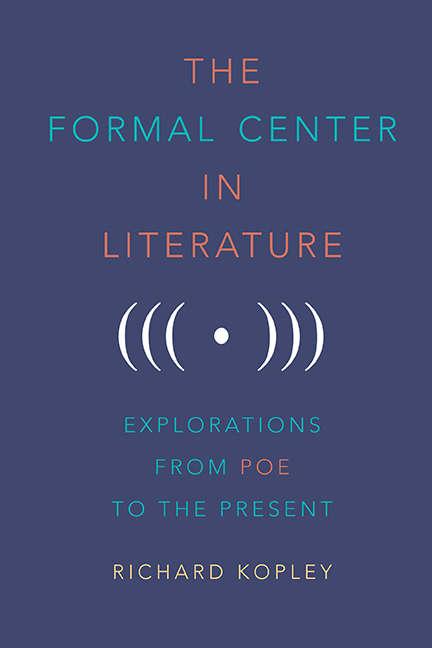Book contents
- Frontmatter
- Dedication
- Contents
- Acknowledgments
- Introduction
- 1 “Mournful and Never-Ending Remembrance” in Edgar Allan Poe's The Narrative of Arthur Gordon Pym
- 2 Retracing Our Steps in Edgar Allan Poe's “The Man of the Crowd”
- 3 “Scrutinizing the Parchment More Closely”: The Form of “The Gold-Bug” and Its Relationship to That of the Dupin Tales
- 4 Form and Reform in Nathaniel Hawthorne's “Earth's Holocaust”
- 5 The Circle and Its Center in Herman Melville's “Bartleby, the Scrivener”
- 6 Chiasmus in Henry David Thoreau's Walden
- 7 The Mythological Centers of Lewis Carroll's Alice Books
- 8 Table as Text in James Joyce's “The Dead”
- 9 The Structure of Sherwood Anderson's “Hands”
- 10 The Architecture of Ernest Hemingway's “The Three-Day Blow”
- 11 Balance in Dashiell Hammett's The Maltese Falcon
- 12 Framing Caesar in Raymond Chandler's The Big Sleep
- 13 The Ridge of the Domino in Patricia Highsmith's Strangers on a Train
- 14 The “X in the Air” in Joyce Carol Oates's “Where Are You Going, Where Have You Been?”
- 15 The Hybrid Center of Zadie Smith's White Teeth
- Notes
- Bibliography
- Index
13 - The Ridge of the Domino in Patricia Highsmith's Strangers on a Train
Published online by Cambridge University Press: 14 June 2019
- Frontmatter
- Dedication
- Contents
- Acknowledgments
- Introduction
- 1 “Mournful and Never-Ending Remembrance” in Edgar Allan Poe's The Narrative of Arthur Gordon Pym
- 2 Retracing Our Steps in Edgar Allan Poe's “The Man of the Crowd”
- 3 “Scrutinizing the Parchment More Closely”: The Form of “The Gold-Bug” and Its Relationship to That of the Dupin Tales
- 4 Form and Reform in Nathaniel Hawthorne's “Earth's Holocaust”
- 5 The Circle and Its Center in Herman Melville's “Bartleby, the Scrivener”
- 6 Chiasmus in Henry David Thoreau's Walden
- 7 The Mythological Centers of Lewis Carroll's Alice Books
- 8 Table as Text in James Joyce's “The Dead”
- 9 The Structure of Sherwood Anderson's “Hands”
- 10 The Architecture of Ernest Hemingway's “The Three-Day Blow”
- 11 Balance in Dashiell Hammett's The Maltese Falcon
- 12 Framing Caesar in Raymond Chandler's The Big Sleep
- 13 The Ridge of the Domino in Patricia Highsmith's Strangers on a Train
- 14 The “X in the Air” in Joyce Carol Oates's “Where Are You Going, Where Have You Been?”
- 15 The Hybrid Center of Zadie Smith's White Teeth
- Notes
- Bibliography
- Index
Summary
WRITING THE SCREENPLAY for Patricia Highsmith's 1950 novel Strangers on a Train, Raymond Chandler was challenged by the fact that the potential hero acted as he did, including murdering a man he didn't know, who had done him no harm. Chandler wrote to director Alfred Hitchcock, “The great difficulty of the story always was to make it credible to an audience that Guy should behave in the damnfool way in which he did behave.” Accordingly, Chandler modified the story so that Guy does not kill Bruno's father. But by strengthening the novel's credibility, Chandler diminished its formal balance. Evidently unwilling to suspend disbelief, the screenwriter suspended an element of symmetry. And even as the novel Strangers on a Train has a symmetry of plot, it also has a rough symmetry of language and a significant center. For a fuller understanding of Highsmith's nowclassic work, we should attend to its structure. I will begin with the story itself and then focus on the symmetry of plot and language and the center that they frame. I will also explore a vital classical allusion, which relates to the work's structure.
Highsmith had the idea for the story—two men exchange murders to eliminate any incriminating motive—in Hastings-on-Hudson in late 1945. She began writing the novel in June 1947, continuing with the project at Yaddo, in Saratoga Springs, New York, in May through July 1948, and later in New York City; the book was published by Harper & Brothers in March 1950. A brief plot summary may be helpful here.
Guy Haines, a young architect, and Charles A. Bruno, a bored, alcoholic, young ne'er-do-well—perhaps insane, certainly without conscience— meet on a train headed west through Texas. In his train compartment, Bruno confides to Guy (as Highsmith calls the characters) his hatred of his father and prompts Guy to reveal his efforts to divorce his unfaithful wife, Miriam, who may be reluctant to grant the divorce and might stand in the way of an important commission. To solve both their problems, Bruno proposes what he terms “the idea of my life”—that he kill Guy's wife and that Guy kill Bruno's father. They'll get away with it, he argues, because of the absence of motive.
- Type
- Chapter
- Information
- The Formal Center in LiteratureExplorations from Poe to the Present, pp. 107 - 115Publisher: Boydell & BrewerPrint publication year: 2018

